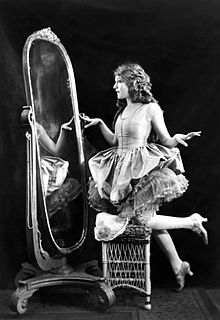Mary Pickford
She was a significant figure in the development of film acting and is credited with having defined the ingénue type in cinema, a persona that also earned her the nickname "America's Sweetheart".
[5] In 1919, she co-founded United Artists alongside Charlie Chaplin, Douglas Fairbanks, and D. W. Griffith, and was also one of the 36 founders of the Academy of Motion Picture Arts and Sciences in 1927.
Mary Pickford was born Gladys Louise Smith [1] in 1892, at 211 University Avenue, Toronto, Ontario,[6] now the location of the Hospital for Sick Children.
[7][8] After being widowed in 1898, Charlotte Smith began taking in boarders, one of whom was a Mr. Murphy, the theatrical stage manager for Cummings Stock Company, who soon suggested that Gladys, then age seven, and Lottie, then age six, be given two small theatrical roles—Gladys portrayed a girl and a boy, while Lottie was cast in a silent part in the company's production of The Silver King at Toronto's Princess Theatre (destroyed by fire in 1915, rebuilt, demolished in 1931), while their mother played the organ.
[9][6] Pickford subsequently acted in many melodramas with Toronto's Valentine Stock Company, finally playing the major child role in its version of The Silver King.
She capped her short career in Toronto with the starring role of Little Eva in the Valentine production of Uncle Tom's Cabin, adapted from the 1852 novel.
After six impoverished years, Pickford allowed one more summer to land a leading role on Broadway, planning to quit acting if she failed.
Pickford, like all actors at Biograph, played both leading roles and bit parts, including mothers, ingénues, charwomen, spitfires, slaves, Native Americans, spurned women, and a prostitute.
That year, Pickford also introduced Dorothy and Lillian Gish—whom she had befriended as new neighbors from Ohio[19]—to Griffith,[6] and each became a major silent film star, in comedy and tragedy, respectively.
Zukor believed film's potential lay in recording theatrical players in replicas of their most famous stage roles and productions.
Biographer Kevin Brownlow observed that the film "sent her career into orbit and made her the most popular actress in America, if not the world".
On June 24, 1916, Pickford signed a new contract with Zukor that granted her full authority over production of the films in which she starred,[22] and a record-breaking salary of $10,000 a week.
[23] In addition, Pickford's compensation was half of a film's profits, with a guarantee of $1.04 million (US$22,040,000 in 2025),[24] making her the first actress to sign a million-dollar contract.
[25] In August 1918, Pickford's contract expired and, when refusing Zukor's terms for a renewal, she was offered $250,000 to leave the motion picture business.
[26] In 1919, Pickford, along with D. W. Griffith, Charlie Chaplin, and Douglas Fairbanks, formed the independent film production company United Artists.
[27] During this period, she also made Little Annie Rooney (1925), another film in which Pickford played a child, Sparrows (1926), which blended the Dickensian with newly minted German expressionist style, and My Best Girl (1927), a romantic comedy featuring her future husband Charles "Buddy" Rogers.
[29] Pickford's hair had become a symbol of female virtue, and when she cut it, the act made front-page news in The New York Times and other papers.
On March 29, 1928, The Dodge Brothers Hour was broadcast from Pickford's bungalow, featuring Fairbanks, Chaplin, Norma Talmadge, Gloria Swanson, John Barrymore, D. W. Griffith, and Dolores del Río, among others.
[33] A transition in the roles Pickford selected came when she was in her late thirties, no longer able to play the children, teenage spitfires, and feisty young women so adored by her fans, and not suited for the glamorous and vampish heroines of early sound.
[14] At the end of World War I, Pickford conceived of the Motion Picture Relief Fund, an organization to help financially needy actors.
In 1932, Pickford spearheaded the "Payroll Pledge Program", a payroll-deduction plan for studio workers who gave one half of one percent of their earnings to the MPRF.
As a result, in 1940, the Fund was able to purchase land and build the Motion Picture Country House and Hospital, in Woodland Hills, California.
According to her Foundation, "she oversaw every aspect of the making of her films, from hiring talent and crew to overseeing the script, the shooting, the editing, to the final release and promotion of each project".
[36] In 1919, she increased her power by co-founding United Artists (UA) with Charlie Chaplin, D. W. Griffith, and her soon-to-be husband, Douglas Fairbanks.
[6] The couple's marriage was strained by Moore's alcoholism, insecurity about living in the shadow of Pickford's fame, and bouts of domestic violence.
The couple's triumphant return to Hollywood was witnessed by vast crowds who turned out to hail them at railway stations across the United States.
Even at private parties, people instinctively stood up when Pickford entered a room; she and her husband were often referred to as "Hollywood royalty".
Other guests included George Bernard Shaw, Albert Einstein, Elinor Glyn, Helen Keller, H. G. Wells, Lord Mountbatten, Fritz Kreisler, Amelia Earhart, F. Scott Fitzgerald, Noël Coward, Max Reinhardt, Baron Nishi, Vladimir Nemirovich-Danchenko,[42] Sir Arthur Conan Doyle, Austen Chamberlain, Sir Harry Lauder, and Meher Baba, among others.
When their film careers both began to flounder at the end of the silent era, Fairbanks' restless nature prompted him to overseas travel (something which Pickford did not enjoy).
Pickford withdrew and gradually became a recluse, remaining almost entirely at Pickfair and allowing visits only from Lillian Gish, her stepson Douglas Fairbanks Jr., and a few select others.











